Renovating
How to Make a Small New-build Flat Feel Larger
Can small mean beautiful when it comes to your new-build home? Yes, say these experts
Space – we all want more of it, but buyers of new-build flats are often faced with less. Does a small property mean having to sacrifice a sense of spaciousness, though? Not necessarily – sometimes it’s simply a matter of tricking the eye. Here, a panel of experts share their top tactics.
Professional advice from: Olga Alexeeva of Black & Milk; Catherine Gillespie of Homeconcepts; Emma Painter of Emma Painter Interiors; Kirsten Wilson of Kirsten M Wilson Design
Professional advice from: Olga Alexeeva of Black & Milk; Catherine Gillespie of Homeconcepts; Emma Painter of Emma Painter Interiors; Kirsten Wilson of Kirsten M Wilson Design
Visually raise the ceiling
New builds typically aren’t blessed with the lofty ceilings you might see in older properties. If you hanker after a high-ceiling look, a large patterned or colourful rug may help to make yours seem taller.
“It really grounds the room, giving depth and visually stretching the height of the space when contrasted with pale walls and ceiling,” Emma Painter says.
Trick the eye with low-slung furniture that gives the impression of more headroom. Forget decorative pendants and install discreet, flush-mounted lighting that lends a sleek, uninterrupted look to the room.
Again, smart shelving is a good move. “Floor-to-ceiling bookshelves or even a shelf that starts above the doorway and goes around the room will draw the eyes up and away,” Kirsten Wilson says. “Plus, it creates more storage space: win-win.”
New builds typically aren’t blessed with the lofty ceilings you might see in older properties. If you hanker after a high-ceiling look, a large patterned or colourful rug may help to make yours seem taller.
“It really grounds the room, giving depth and visually stretching the height of the space when contrasted with pale walls and ceiling,” Emma Painter says.
Trick the eye with low-slung furniture that gives the impression of more headroom. Forget decorative pendants and install discreet, flush-mounted lighting that lends a sleek, uninterrupted look to the room.
Again, smart shelving is a good move. “Floor-to-ceiling bookshelves or even a shelf that starts above the doorway and goes around the room will draw the eyes up and away,” Kirsten Wilson says. “Plus, it creates more storage space: win-win.”
Focus on furniture and accessories
The proportions of new-build flats can often be on the small side, making multifunctional a potential lifesaver, as cramming too much furniture into small rooms can result in a home that feels cramped or claustrophobic.
Free up space with a desk that doubles up as a dining table, for example, or invest in a room divider that’s also a bookcase. Boost storage in your bedroom with a bed that lifts up to reveal a wealth of hidden space, or that comes with generous drawers.
“Choose furniture that stands on legs, so you can see through to the floor or the back wall. This will create more empty space, which you’ll lack in a small room,” Kirsten says.
Find architects, interior designers and builders in your area on Houzz.
The proportions of new-build flats can often be on the small side, making multifunctional a potential lifesaver, as cramming too much furniture into small rooms can result in a home that feels cramped or claustrophobic.
Free up space with a desk that doubles up as a dining table, for example, or invest in a room divider that’s also a bookcase. Boost storage in your bedroom with a bed that lifts up to reveal a wealth of hidden space, or that comes with generous drawers.
“Choose furniture that stands on legs, so you can see through to the floor or the back wall. This will create more empty space, which you’ll lack in a small room,” Kirsten says.
Find architects, interior designers and builders in your area on Houzz.
Foldaway furniture can also work wonders. Kirsten suggests a wall-mounted, drop-leaf desk or kitchen table that will sit flat against the wall when not in use. Glass furniture is another clever addition. Although it’s not necessarily space-saving, it will amplify light, giving rooms an airy feel.
“Play with scale,” Emma suggests. “Make a space seem larger by drawing attention to a large-scale item, such as an oversized lamp or picture. It also adds a fun element to any room.”
“Play with scale,” Emma suggests. “Make a space seem larger by drawing attention to a large-scale item, such as an oversized lamp or picture. It also adds a fun element to any room.”
Stick to the property’s style
“Don’t try to recreate a traditional interior in modern architecture, such as adding fake architectural details like coving or fancy skirting boards,” Olga Alexeeva says. “Each architectural style has its own interior direction it works in harmony with.” Fussy details in a modern property also run the risk of making a petite space look cluttered.
Instead, opt for a subtle but sumptuous look to make your new-build flat feel your own. Olga suggests that natural wood, marble or stone, metal detailing, luxe fabrics and accessories will bring a sense of grandeur, while Kirsten advises a feature wall with brick or wallpaper, or personalised storage.
“Invest in customised built-in bookshelves or add a single standalone bookshelf that attaches to the wall from floor to ceiling,” Kirsten adds.
While installing faux period detailing may be fruitless, there may be more interesting versions of what your flat came with. “Replace your doors with some that have character,” she suggests.
More: How to Start a Kitchen Renovation
“Don’t try to recreate a traditional interior in modern architecture, such as adding fake architectural details like coving or fancy skirting boards,” Olga Alexeeva says. “Each architectural style has its own interior direction it works in harmony with.” Fussy details in a modern property also run the risk of making a petite space look cluttered.
Instead, opt for a subtle but sumptuous look to make your new-build flat feel your own. Olga suggests that natural wood, marble or stone, metal detailing, luxe fabrics and accessories will bring a sense of grandeur, while Kirsten advises a feature wall with brick or wallpaper, or personalised storage.
“Invest in customised built-in bookshelves or add a single standalone bookshelf that attaches to the wall from floor to ceiling,” Kirsten adds.
While installing faux period detailing may be fruitless, there may be more interesting versions of what your flat came with. “Replace your doors with some that have character,” she suggests.
More: How to Start a Kitchen Renovation
Don’t waste space
It may sound obvious, but make every item count. You may not have much space, but you can invest every piece you have with a purpose and a personality, especially helpful in a new-build with few details of architectural interest.
“Painting a piece of furniture in a bright colour can instantly transform a room, lifting it out of the ordinary,” Emma says. “Place a picture shelf on the wall with an interesting collection of your favourite items – photos, small vase – to draw the eye and add interest. Mix vintage with contemporary items for a timeless feel.”
It may sound obvious, but make every item count. You may not have much space, but you can invest every piece you have with a purpose and a personality, especially helpful in a new-build with few details of architectural interest.
“Painting a piece of furniture in a bright colour can instantly transform a room, lifting it out of the ordinary,” Emma says. “Place a picture shelf on the wall with an interesting collection of your favourite items – photos, small vase – to draw the eye and add interest. Mix vintage with contemporary items for a timeless feel.”
Branch out with a balcony
If you have a balcony, as quite a few new-build apartments do, turn it into an extension of your living space by adding an outdoor rug, small-scale furniture and potted plants.
“Keep the flow from inside to outside by using colours and textures that coordinate with the interior spaces to create a cohesive look and feeling of continuity,” Emma says. “Bringing a few potted plants inside will also make the balcony feel like an extension of your inside space, therefore making it appear more generous.”
Olga suggests installing low-level closed storage along the balcony wall. “It can function as a seating area and give you a valuable storage solution,” she says.
If you have a balcony, as quite a few new-build apartments do, turn it into an extension of your living space by adding an outdoor rug, small-scale furniture and potted plants.
“Keep the flow from inside to outside by using colours and textures that coordinate with the interior spaces to create a cohesive look and feeling of continuity,” Emma says. “Bringing a few potted plants inside will also make the balcony feel like an extension of your inside space, therefore making it appear more generous.”
Olga suggests installing low-level closed storage along the balcony wall. “It can function as a seating area and give you a valuable storage solution,” she says.
Conceal your clutter
Good storage is key, Emma says. “A cluttered space isn’t conducive to happy living. Stuff is distracting and quickly makes a space appear smaller.”
Unfortunately, cupboards are often in short supply in new-build flats, which have fewer storage-suitable nooks and alcoves than period properties, so it’s likely you’ll need to create your own storage space. Freestanding furniture is generally cheaper, but you could also consider custom-made floor-to-ceiling storage to make the most of the height of the room.
Recessed shelving and niches are another neat trick, adding depth to a space without encroaching on it. If it’s not possible to recess, opt for shelving that’s scaled for smaller spaces.
Good storage is key, Emma says. “A cluttered space isn’t conducive to happy living. Stuff is distracting and quickly makes a space appear smaller.”
Unfortunately, cupboards are often in short supply in new-build flats, which have fewer storage-suitable nooks and alcoves than period properties, so it’s likely you’ll need to create your own storage space. Freestanding furniture is generally cheaper, but you could also consider custom-made floor-to-ceiling storage to make the most of the height of the room.
Recessed shelving and niches are another neat trick, adding depth to a space without encroaching on it. If it’s not possible to recess, opt for shelving that’s scaled for smaller spaces.
Boost light levels
As already mentioned, new-build flats often lack interesting architectural features, so use multiple light sources to create instant interest after dark. For example, team downlights with lamps, which will inject drama and warmth into a room.
Beware of using too many table lamps, though. They’re great for mood lighting, but they can create a sense of clutter if you don’t have enough surfaces to perch them on. A couple of carefully sited lamps will serve your purposes if they’re teamed with wall lights – there are lots on the market that don’t need wiring in.
Catherine Gillespie of Homeconcepts recommends dimmable lighting in a small space: that way, you keep surfaces clear, but can adapt light levels to the time of day and the atmosphere you want to create.
Mirrors are an excellent space-enhancer, too, reflecting the natural light you have and creating more, thus enlarging the look and feel of a space. “Think about what will be reflected, and position your mirror to create the most pleasing effect,” Emma says. “For example, a reflected pendant can transform a room and a mirror placed to reflect the outside view can make a room feel more generous.”
Avoid using low-hanging pendant lights, as these can make the upper part of the room dark. “Recessed downlights or track lighting can provide lots of light without taking up space,” Catherine says.
As already mentioned, new-build flats often lack interesting architectural features, so use multiple light sources to create instant interest after dark. For example, team downlights with lamps, which will inject drama and warmth into a room.
Beware of using too many table lamps, though. They’re great for mood lighting, but they can create a sense of clutter if you don’t have enough surfaces to perch them on. A couple of carefully sited lamps will serve your purposes if they’re teamed with wall lights – there are lots on the market that don’t need wiring in.
Catherine Gillespie of Homeconcepts recommends dimmable lighting in a small space: that way, you keep surfaces clear, but can adapt light levels to the time of day and the atmosphere you want to create.
Mirrors are an excellent space-enhancer, too, reflecting the natural light you have and creating more, thus enlarging the look and feel of a space. “Think about what will be reflected, and position your mirror to create the most pleasing effect,” Emma says. “For example, a reflected pendant can transform a room and a mirror placed to reflect the outside view can make a room feel more generous.”
Avoid using low-hanging pendant lights, as these can make the upper part of the room dark. “Recessed downlights or track lighting can provide lots of light without taking up space,” Catherine says.
Consider your room’s dimensions
Measure your room and check the dimensions of any furniture that’s caught your eye before making any purchases. That way, you can make sure new pieces don’t end up overwhelming your space. And again, if you have modern floor-to-ceiling windows, as in this new-build, aim to let light through rather than block it with too-big furniture.
It’s also important to think about foot traffic, and to be prepared to part company with some pieces of furniture to create a space that you can move around in. “Place furniture so there’s good flow around the space,” Emma says. “Only keep what you need and remember that, in a small space, less is definitely more.”
Once you’ve decided what to ditch and what to keep, consider how much space you need around each item. For example, a dining chair doesn’t always live under the table: you need to allow space to pull out a chair and for comfortable sitting. “It sounds simple, but if you get this wrong, you’ll really notice it,” Emma says.
Measure your room and check the dimensions of any furniture that’s caught your eye before making any purchases. That way, you can make sure new pieces don’t end up overwhelming your space. And again, if you have modern floor-to-ceiling windows, as in this new-build, aim to let light through rather than block it with too-big furniture.
It’s also important to think about foot traffic, and to be prepared to part company with some pieces of furniture to create a space that you can move around in. “Place furniture so there’s good flow around the space,” Emma says. “Only keep what you need and remember that, in a small space, less is definitely more.”
Once you’ve decided what to ditch and what to keep, consider how much space you need around each item. For example, a dining chair doesn’t always live under the table: you need to allow space to pull out a chair and for comfortable sitting. “It sounds simple, but if you get this wrong, you’ll really notice it,” Emma says.
Use your sofa to your advantage
In a small living room, if you have the space, one large sofa instead of multiple small pieces cuts the feeling of clutter and makes the room look less cramped. Again, choose a sofa that’s raised from the ground: the space between the floor and the sofa base keeps the floor on view.
Warm up the floor with a generous rug that visually pulls the various elements of the space together. “It should sit almost halfway under the sofa and cover all of the seating area,” Olga says. “A small rug will disjoint the area and make the pieces of furniture look random and chaotic, making the space look even smaller than it is.”
How you arrange your small living room can also affect your perception of space. “If you have a big window in the room, arrange the sofa to face it, so that when you or your guests are sitting down, they’re focusing on the open-air space rather than your small room,” Kirsten says.
A simple way to trick the eye is to pull furniture slightly away from the wall, as seen here. Creating a small gap gives the illusion that the wall is further away than it actually is.
In a small living room, if you have the space, one large sofa instead of multiple small pieces cuts the feeling of clutter and makes the room look less cramped. Again, choose a sofa that’s raised from the ground: the space between the floor and the sofa base keeps the floor on view.
Warm up the floor with a generous rug that visually pulls the various elements of the space together. “It should sit almost halfway under the sofa and cover all of the seating area,” Olga says. “A small rug will disjoint the area and make the pieces of furniture look random and chaotic, making the space look even smaller than it is.”
How you arrange your small living room can also affect your perception of space. “If you have a big window in the room, arrange the sofa to face it, so that when you or your guests are sitting down, they’re focusing on the open-air space rather than your small room,” Kirsten says.
A simple way to trick the eye is to pull furniture slightly away from the wall, as seen here. Creating a small gap gives the illusion that the wall is further away than it actually is.
Choose pale wall colours to maximise space…
The joy of newer buildings is that they tend to be easier to decorate as, unlike period properties, there aren’t usually walls to repair, wonky bits and gaps where there shouldn’t be. However, do make sure the walls have fully dried out first. This can take between nine and 12 months from the original plastering.
Although the builders will have already painted, you are likely to get tiny cracks in the finish due to shrinkage so don’t waste good paint on redoing the job until the plaster has settled. (For more on this, check out page 15 of the really useful Guide to Your New Home, put together by the NHBC, an independent standard-setter and provider of warranty and insurance for new homes.)
The general consensus is that darker colours will make a room feel warm and cosy, but they’ll absorb light rather than reflect it. So, in a small modern home, stick to paler colours that will brighten and lighten key rooms and make them feel bigger.
This doesn’t mean you have to be bland. Emma recommends creating contrast by choosing a darker colour for your skirting boards and teaming it with a paler colour for the walls. This will open up the room.
The joy of newer buildings is that they tend to be easier to decorate as, unlike period properties, there aren’t usually walls to repair, wonky bits and gaps where there shouldn’t be. However, do make sure the walls have fully dried out first. This can take between nine and 12 months from the original plastering.
Although the builders will have already painted, you are likely to get tiny cracks in the finish due to shrinkage so don’t waste good paint on redoing the job until the plaster has settled. (For more on this, check out page 15 of the really useful Guide to Your New Home, put together by the NHBC, an independent standard-setter and provider of warranty and insurance for new homes.)
The general consensus is that darker colours will make a room feel warm and cosy, but they’ll absorb light rather than reflect it. So, in a small modern home, stick to paler colours that will brighten and lighten key rooms and make them feel bigger.
This doesn’t mean you have to be bland. Emma recommends creating contrast by choosing a darker colour for your skirting boards and teaming it with a paler colour for the walls. This will open up the room.
…but go dark in the hall
Surprisingly, a flash of colour can work well in a narrow space such as a hallway, because the eye is drawn to the colour rather than the size of the space. “You can play with the eye by painting a hall dark and the rooms beyond it lighter,” Emma says. “The hall will appear cosy, but there will be a greater sense of space beyond.”
Surprisingly, a flash of colour can work well in a narrow space such as a hallway, because the eye is drawn to the colour rather than the size of the space. “You can play with the eye by painting a hall dark and the rooms beyond it lighter,” Emma says. “The hall will appear cosy, but there will be a greater sense of space beyond.”
Boost your bathroom
Generally, a new-build bathroom comes complete with the essentials already in place, so aim to work with what you’ve got.
Boost storage by opting for a mirrored cabinet rather than a mirror above your basin. If you’re still lacking space, make the most of the height of the room by installing floating shelves (glass ones will encroach less).
Even small touches, such as a transparent toothbrush holder or soap dispenser, can help to make a countertop look less cluttered. And don’t forget to use your shower for storing essentials. A simple shower caddy will keep shampoos, conditioners and body scrubs under control.
Don’t worry if your new-build bathroom is windowless. White walls will reflect light and make the space look bigger. Mirrors also help to expand the space. Keep in mind that the bigger the mirror, the more space it will appear to create.
More: How to Plan for a Bathroom Renovation
Generally, a new-build bathroom comes complete with the essentials already in place, so aim to work with what you’ve got.
Boost storage by opting for a mirrored cabinet rather than a mirror above your basin. If you’re still lacking space, make the most of the height of the room by installing floating shelves (glass ones will encroach less).
Even small touches, such as a transparent toothbrush holder or soap dispenser, can help to make a countertop look less cluttered. And don’t forget to use your shower for storing essentials. A simple shower caddy will keep shampoos, conditioners and body scrubs under control.
Don’t worry if your new-build bathroom is windowless. White walls will reflect light and make the space look bigger. Mirrors also help to expand the space. Keep in mind that the bigger the mirror, the more space it will appear to create.
More: How to Plan for a Bathroom Renovation
Take kitchen storage to the ceiling
If you have the chance to specify your small new-build kitchen, seek out compact appliances, and maximise vertical space by installing units that stretch right up to the ceiling, as seen here. Pull-out larders are particularly useful, as they’re easy to access and often designed to be narrower than a standard 60cm unit, so they’re ideal for slotting into narrow spaces.
The less space you have, the smarter you have to be with it. For example, if the space between your worktop and wall units isn’t being used, install a hanging rail to keep essentials close to hand. Peninsulas are a popular addition to compact kitchens, doing the job of an island but attached to a wall at one end, therefore taking up less room.
In a kitchen that’s already been installed, even small changes can make a big difference. For example, replacing your kettle with a boiling-water tap will save worktop space.
Tell us…
What advice do you have for transforming a new-build flat? Share your tips in the Comments.
If you have the chance to specify your small new-build kitchen, seek out compact appliances, and maximise vertical space by installing units that stretch right up to the ceiling, as seen here. Pull-out larders are particularly useful, as they’re easy to access and often designed to be narrower than a standard 60cm unit, so they’re ideal for slotting into narrow spaces.
The less space you have, the smarter you have to be with it. For example, if the space between your worktop and wall units isn’t being used, install a hanging rail to keep essentials close to hand. Peninsulas are a popular addition to compact kitchens, doing the job of an island but attached to a wall at one end, therefore taking up less room.
In a kitchen that’s already been installed, even small changes can make a big difference. For example, replacing your kettle with a boiling-water tap will save worktop space.
Tell us…
What advice do you have for transforming a new-build flat? Share your tips in the Comments.




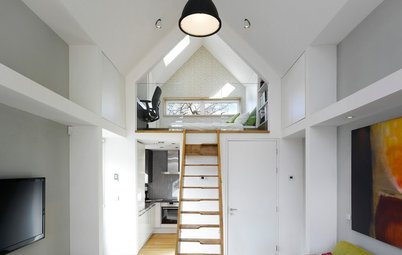
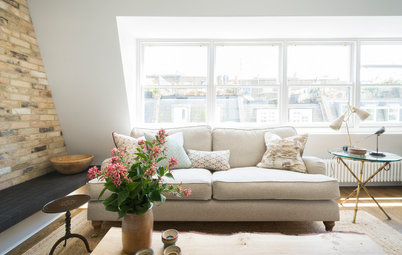
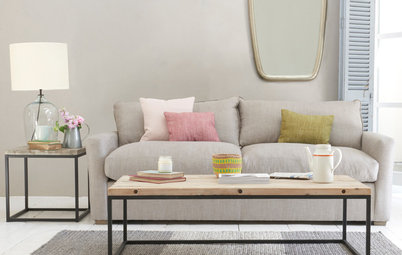
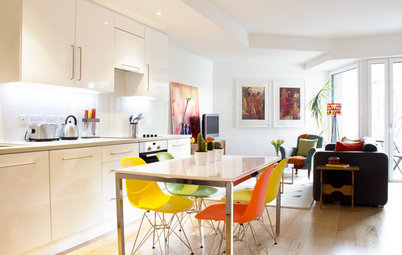

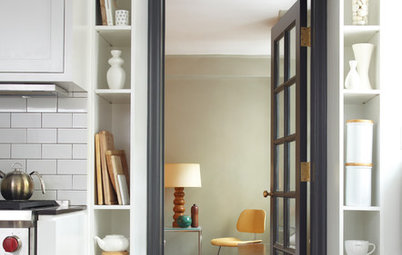
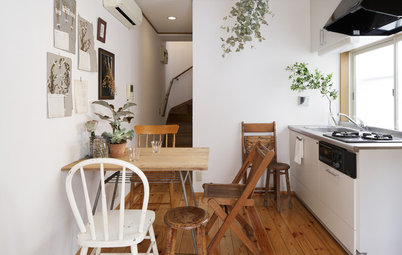
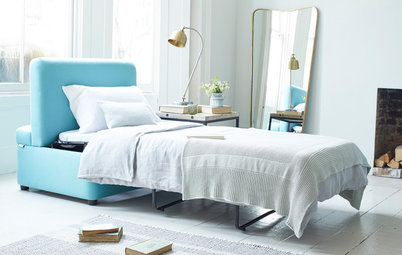
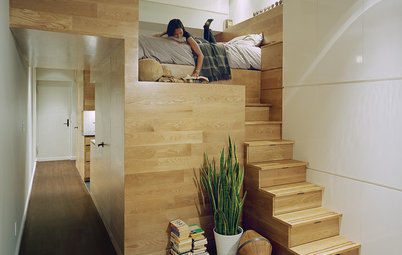
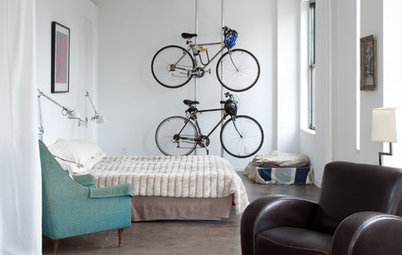
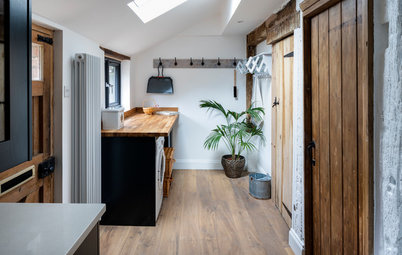
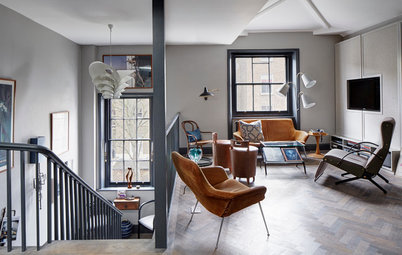
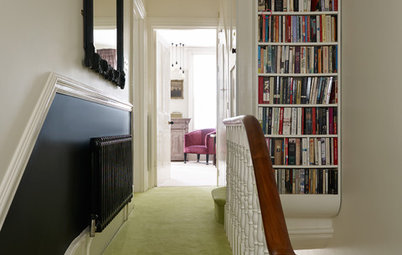
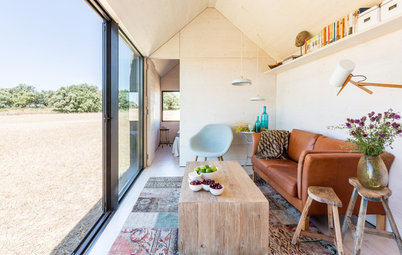


Many new builds feature floor-to-ceiling windows that allow lots of natural light to flood in. On the plus side, this will often make the space look bigger than it is. The drawback, though, is that generous windows take up valuable wall space that could otherwise be used for storage, which presents a problem when you have lots of possessions to stash.
Resist the temptation to pile up stuff by the window, which will look unsightly from the outside. Instead, consider positioning your occasional seating – an armchair angled so you can enjoy the view; an attractive low ottoman, or (very practical) a storage bench with cushions on top – by the window. This will look better from the outside and free up space elsewhere in the room.
Open-backed shelving, if you’re strict with your displays, can also look good inside and out; as long as you don’t fill up the shelves completely, you’ll still have a view.
If you don’t wish to restrict natural light, think smart in terms of storage solutions elsewhere. Taking wall-mounted bookshelves and cupboards to the ceiling makes excellent use of vertical space. Perhaps set your sights even higher and use the space over a doorway for a shallow shelf for books or, in a bathroom, towels.